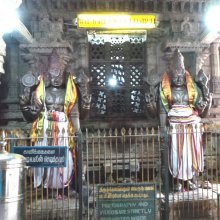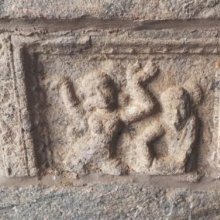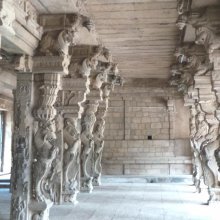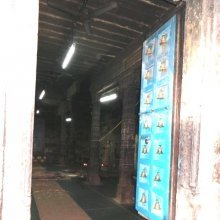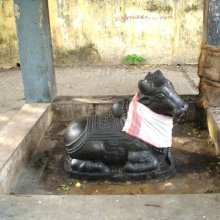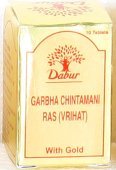Garbha, Garbhā, Gārbha: 35 definitions
Introduction:
Garbha means something in Buddhism, Pali, Hinduism, Sanskrit, Jainism, Prakrit, the history of ancient India, Marathi, Hindi, biology. If you want to know the exact meaning, history, etymology or English translation of this term then check out the descriptions on this page. Add your comment or reference to a book if you want to contribute to this summary article.
Alternative spellings of this word include Garbh.
Images (photo gallery)
(+42 more images available)
In Hinduism
Natyashastra (theatrics and dramaturgy)
Source: Wisdom Library: Nāṭya-śāstraGarbha (गर्भ, “development”) refers to one of the “five segments” of the plot (itivṛtta or vastu) of a dramatic play (nāṭaka), according to the Nāṭyaśāstra chapter 21. These five segments are assigned to the principal plot (ādhikārika).
Source: archive.org: Natya ShastraGarbha (गर्भ).—One of the five segments (sandhi) of a dramatic play;—The sprouting of the Seed, its attainment or nonattainment and search for it, is called the Development (garbha).

Natyashastra (नाट्यशास्त्र, nāṭyaśāstra) refers to both the ancient Indian tradition (shastra) of performing arts, (natya—theatrics, drama, dance, music), as well as the name of a Sanskrit work dealing with these subjects. It also teaches the rules for composing Dramatic plays (nataka), construction and performance of Theater, and Poetic works (kavya).
Shaivism (Shaiva philosophy)
Source: Wisdom Library: Kubjikāmata-tantraGarbhā (गर्भा):—One of the nine Dūtī presided over by one of the nine bhaivaravas named Ananta (emanation of Ananta himself, who is the central presiding deity of Dūtīcakra), according to the Kubjikāmata-tantra and the Ṣaṭsāhasrasaṃhitā.

Shaiva (शैव, śaiva) or Shaivism (śaivism) represents a tradition of Hinduism worshiping Shiva as the supreme being. Closely related to Shaktism, Shaiva literature includes a range of scriptures, including Tantras, while the root of this tradition may be traced back to the ancient Vedas.
Purana and Itihasa (epic history)
Source: archive.org: Puranic Encyclopedia1) Garbha (गर्भ).—A son of Bharata, the son of Duṣyanta. Suhotra, Suhotā, Gaya, Garbha and Suketu were the five sons of Bharata. (Agni Purāṇa, Chapter 278). (See full article at Story of Garbha from the Puranic encyclopaedia by Vettam Mani)
2) Garbha (गर्भ).—The Purāṇas have described the views of sages about the origin of ātman in woman’s womb. Asitamahāmuni stated the following about the birth of a child to King Janaka. (Brahmāṇḍa Purāṇa. Chapter
Source: archive.org: Shiva Purana - English TranslationGarbha (गर्भ) refers to the “womb”, according to the Śivapurāṇa 2.3.5.—Accordingly, after Goddess Śivā (i.e., Umā/Durgā) granted a boon to Menā:—“Saying so, the Goddess Śivā vanished from there even as Menā was watching. [...] She told her husband about the boon, which had already been understood by him through good omens, by her words which were rendered useless. On hearing the words of Menā, the lord of mountains became delighted. He praised his wife who was devoted to Śiva lovingly. O sage, when their mutual sexual intercourse took place, Menā conceived and the child in the womb [i.e., garbha] gradually grew up. [...]”.
Source: Cologne Digital Sanskrit Dictionaries: The Purana Index1a) Garbha (गर्भ).—A son of Turvasu.*
- * Matsya-purāṇa 48. 1.
1b) The child in embryo;1 a union of Śukra— springing from majja which is from bone which is due to medas, which again results from flesh, that is due to śoṇita, emerging from Rasa or waters, Śukra constitutes of Soma and soṇitam of Agnī. The former resides in Kaphavarga and the latter in Pittavarga. The place of kapha is heart, and that of pitta is the navel region. Stages in the garbha and formation described.2
- 1) Bhāgavata-purāṇa III. 31. 1-10. Vāyu-purāṇa 97. 46-57.
- 2) Brahmāṇḍa-purāṇa III. 72. 45-57. Vāyu-purāṇa 14. 18-26.
1c) The four central parts out of 16, into which a site (of a temple to be built) is divided; measurements of its foundations, walls, doorways, etc.; likewise other parts of temple bear specific relation to the garbha.*
- * Matsya-purāṇa 269. 1-8.

The Purana (पुराण, purāṇas) refers to Sanskrit literature preserving ancient India’s vast cultural history, including historical legends, religious ceremonies, various arts and sciences. The eighteen mahapuranas total over 400,000 shlokas (metrical couplets) and date to at least several centuries BCE.
Nirukta (Sanskrit etymology)
Source: Shodhganga: Ajanta’s antiquity (nirukta)Garbha (गर्भ, “womb”) is synonymous to womb, foetus, embryo, inner apartment, interior chamber, hole, and hollow. Its root is also traced in grabha, which means to conceive, womb, having in the interior, containing, filled with, inner apartment, sleeping room, interior chamber, adytum, sanctuary of a temple, and the inside, middle, or interior of anything. What garbha is to the human body gṛha and guhā are to the world of habitation.
Nirukta (निरुक्त) or “etymology” refers to the linguistic analysis of the Sanskrit language. This branch studies the interpretation of common and ancient words and explains them in their proper context. Nirukta is one of the six additional sciences (vedanga) to be studied along with the Vedas.
Pancaratra (worship of Nārāyaṇa)
Source: eScholarship: Chapters 1-14 of the Hayasirsa PancaratraGarbha (गर्भ) refers to the “consecration deposit”, as mentioned in the twelfth chapter of the Hayaśīrṣa-pañcarātra, which deals with the offering in the hole according to the different deities, division of the construction of the foundation, and instructions for the measurements for the temple.
Notes: Thus if one takes garbha as consecration deposit and bhājana as repository then garbhabhājana would be consecration deposit repository (or box). Thus the term garbha is the consecration deposit (verse 12.42). In verse 13.6 it seems to be short for garbhagṛha–inner sanctum or aytum–which is also an alternative according to Acharya (womb is his first alternative, 1946:vol. 7, p. 145). The term bhājanam means repository (verse 12.39).
Source: University of Vienna: Sudarśana's Worship at the Royal Court According to the AhirbudhnyasaṃhitāGarbha (गर्भ) refers to the “innermost (of the temple)”, according to the Ahirbudhnyasaṃhitā, belonging to the Pāñcarātra tradition which deals with theology, rituals, iconography, narrative mythology and others.—Accordingly, “An abnormal modification caused by a aggressive ritual against Kings, occurring at the improper time, dreadful and all-reaching, is characterized by the these signs: [...] frightful jackals enter unimpeded the innermost of the temple (garbha-bhavana) and howl loudly at the [morning and evening] twilights, when the sky is lit up; enemies proud of their strength besiege the King’s [capital] city; [...] from such and other signs he should understand that the enemy is performing a aggressive ritual”.

Pancaratra (पाञ्चरात्र, pāñcarātra) represents a tradition of Hinduism where Narayana is revered and worshipped. Closeley related to Vaishnavism, the Pancaratra literature includes various Agamas and tantras incorporating many Vaishnava philosophies.
Shilpashastra (iconography)
Source: Shodhganga: Vaisnava Agamas And Visnu ImagesGarbha (गर्भ) refers to the “core” of the mould in the process beeswax modeling (madhūcchiṣṭa), as defined in treatises such as the Pāñcarātra, Pādmasaṃhitā and Vaikhānasa-āgamas, extensively dealing with the technical features of temple art, iconography and architecture in Vaishnavism.—The Agamas divide the process of Madhūcchiṣṭa-kriyā into three steps:—(a) creation of icon using bee wax (madhūcchiṣṭa), (b) creation of garbha (core or mould in full), (c) casting of metal icon and finishing work. [...] The second step is the creation of garbha (core). The clay, both fine and normal is smeared on the bee wax model, dried for some time, once again smeared and finally iron tapes or metallic strips are wound around the core to strengthen in order to avoid bursting and cracking at the time of drying as well as pouring the molten metal inside the garbha. The garbha is heated and the wax is drained out.
The third step is casting of metal icon and finishing work. The garbha is well heated before the molten metal is poured in. The Āgamas insist on the casting work only in the night, probably for concentration and adjustment of the climate. This takes place after performance of certain sacrificial rituals. The mould with metal poured in should be kept till it becomes cool and solid or strong. The next day morning, the outer shell should be broken carefully to take out the unfinished metal icon.

Shilpashastra (शिल्पशास्त्र, śilpaśāstra) represents the ancient Indian science (shastra) of creative arts (shilpa) such as sculpture, iconography and painting. Closely related to Vastushastra (architecture), they often share the same literature.
Vedanta (school of philosophy)
Source: Shodhganga: Siva Gita A Critical StudyGarbha (गर्भ) or Garbhagītā refers to one of the sixty-four Gītās commonly referred to in Hindu scriptures.—Gītā is the name given to certain sacred writings in verse (often in the form of a dialogue) which are devoted to the exposition of particular religious and theosophical doctrines. Most of these Gītās [i.e., Garbha-gītā] originate from the Mahābhārata or the various Purāṇas.

Vedanta (वेदान्त, vedānta) refers to a school of orthodox Hindu philosophy (astika), drawing its subject-matter from the Upanishads. There are a number of sub-schools of Vedanta, however all of them expound on the basic teaching of the ultimate reality (brahman) and liberation (moksha) of the individual soul (atman).
Vastushastra (architecture)
Source: OpenEdition books: Architectural terms contained in Ajitāgama and RauravāgamaGarbha (गर्भ) refers to “- 1. foundation deposit § 2.24. - 2. = garbhagṛha §§ 4.7; 5.13. - 3. see iṣṭakāgarbha. - 4 · see sagarbha.”.—(For paragraphs cf. Les enseignements architecturaux de l'Ajitāgama et du Rauravāgama by Bruno Dagens)

Vastushastra (वास्तुशास्त्र, vāstuśāstra) refers to the ancient Indian science (shastra) of architecture (vastu), dealing with topics such architecture, sculpture, town-building, fort building and various other constructions. Vastu also deals with the philosophy of the architectural relation with the cosmic universe.
Shaktism (Shakta philosophy)
Source: Google Books: ManthanabhairavatantramGarbha (गर्भ) refers to the “womb” (in the womb of the most excellent body), according to the Kulakaulinīmata verse 20.505cd-508ab.—Accordingly, “Akula is said to be Kaula. It is Maheśvara, the womb (garbha) in the womb of the most excellent body. O mistress of the gods, he is present everywhere. The abode of Kula is in Kaula, that is, in one's own divine Kula, one’s own nature and form devoid of the body. One should enter into the Self by the Self. The Great Goddess engaged in intercourse within the great Śiva is Pārvatī. By means of the bliss (of this union one) attains the supreme principle and by (that) principle, the supreme (state)”.

Shakta (शाक्त, śākta) or Shaktism (śāktism) represents a tradition of Hinduism where the Goddess (Devi) is revered and worshipped. Shakta literature includes a range of scriptures, including various Agamas and Tantras, although its roots may be traced back to the Vedas.
Jyotisha (astronomy and astrology)
Source: Wisdom Library: Brihat Samhita by VarahamihiraGarbha (गर्भ) refers to the “womb”, according to the Bṛhatsaṃhitā (chapter 16) (“On the planets—graha-bhaktiyoga”), an encyclopedic Sanskrit work written by Varāhamihira mainly focusing on the science of ancient Indian astronomy astronomy (Jyotiṣa).—Accordingly, “[...] Rāhu also presides over the most wicked in the family, over torturers, ungrateful men, thieves, persons who are untruthful, uncleanly and ungenerous; over ass-riders, duelists, persons of easily irritable temperament, infants in the womb (garbha-āśaya) and Cāṇḍālas. [...]”.

Jyotisha (ज्योतिष, jyotiṣa or jyotish) refers to ‘astronomy’ or “Vedic astrology” and represents the fifth of the six Vedangas (additional sciences to be studied along with the Vedas). Jyotisha concerns itself with the study and prediction of the movements of celestial bodies, in order to calculate the auspicious time for rituals and ceremonies.
General definition (in Hinduism)
Source: Leiden Repository: Chapter 6 The function and meaning of the garbhanyāsaThe fertility aspect of garbhanyāsa is reflected in the very term by which the ritual is referred to, which means ‘the depositing (nyāsa) of the embryo (garbha)’.
According to the majority of the texts, the garbha should be installed at night, for – as formulated by one work – if done du ring daytime it will be destroyed. The Kāśyapaśilpa, moreover, warns that one should not stay in a house without a garbha and assures that no god will ever commit such a deed.
Apart from the association with an embryo, the texts provide other hints as to the nature of the garbha, all of them, however, emphasising the life-giving character of the deposit. In certain works the deposit is equated with earth or the earth is invoked to enter the deposit casket. The invocation is pronounced before the final act of placing the casket in the pr escribed location. This is not surprising considering that the contents of the deposit casket chiefly consist of the ‘riches of the earth’, such as minerals, metals, grains, herbs and soil taken from various locations (from a river, a marsh or a mountain), which represent the totality of the earth.
In Buddhism
Mahayana (major branch of Buddhism)
Source: academia.edu: A Study and Translation of the Gaganagañjaparipṛcchā1) Garbha (गर्भ) refers to the “womb”, according to the Gaganagañjaparipṛcchā: the eighth chapter of the Mahāsaṃnipāta (a collection of Mahāyāna Buddhist Sūtras).—Accordingly: “[...] Immediately after those two sons (Siṃha and Siṃhavikrāntagāmin) were born, in one voice they spoke the following verses to their father, the kind Puṇyālaṃkāra: ‘[...] (167) The liberation of thoughts by one-pointed meditation, never forgetting the profound reflection and insight, making actions through knowledge all the time—because of these undisturbed dharmas, it is not difficult to attain awakening. (168) One who is not sullied by vices, who is not established in womb (garbha), and who is miraculously born is unsullied just as a lotus does not get wet with water. [...]’”.
2) Garbha (गर्भ) refers to the “essence (of diamond)”, according to the Gaganagañjaparipṛcchā.—Accordingly, “The venerable Ānanda said this to the Lord: ‘O Lord, when will the wicked māra wake up to incomparable complete awakening? What will he be called after having attained the awakening? And what will be the name of that universe?’ The Lord said: ‘Ānanda, the wicked Māra, doing the works of the māra in the Buddha-fields of ten directions again and again, will hear the dharma of destroying vices by the essence of diamond (vajra-garbha) from the awakened Buddhas there, and will see the secret practice, behaviour, good qualities, maintaining morality, practice, ceremony and application of the Buddhas and the Bodhisattvas. [...]’”.

Mahayana (महायान, mahāyāna) is a major branch of Buddhism focusing on the path of a Bodhisattva (spiritual aspirants/ enlightened beings). Extant literature is vast and primarely composed in the Sanskrit language. There are many sūtras of which some of the earliest are the various Prajñāpāramitā sūtras.
General definition (in Buddhism)
Source: Thrangu Rinpoche: Uttaratantra as taught at ShambhalaThe Sanskrit word garbha can mean a variety of things, “womb” or “a germ” (of a seed) where something is created or grows out of. This was translated by Takasaki as “matrix” because matrix in Latin means “womb,” and is “something within which something else originates or develops ” (Merriam-Webster’s New Collegiate Dictionary). The word garbha also means the “essence” or the “essential nature” which gives us the phrase “Buddha-essence” or essence of the Buddha.
In Jainism
General definition (in Jainism)
Source: Encyclopedia of Jainism: Tattvartha Sutra 2: the Category of the livingGarbha (गर्भ, “womb”) refers to the uterus or womb and represents one of the three types of birth (janman, method of getting born), according to the 2nd-century Tattvārthasūtra 2.31. What is the meaning of uterus birth (garbha)? The birth that occur due to the union of the sperm of the father and the egg of the mother in the womb of the mother is called uterus birth e.g. of human beings.
Which living beings have the uterine birth (garbha, birth from the uterus)? The living beings with placenta (jarāyuja), egg (aṇḍaja) and without placenta (potaja) have uterine birth.
Source: The University of Sydney: A study of the Twelve ReflectionsGarbha (गर्भ) refers to the “womb”, according to the 11th century Jñānārṇava, a treatise on Jain Yoga in roughly 2200 Sanskrit verses composed by Śubhacandra.—Accordingly, “O fool, sentient beings, having begun from the womb (garbha), are continually led by [their own] action to Yama’s abode by means of uninterrupted journeys. If there is a powerful [man], seen or heard about, who opposes the command of Yama, having honoured him you must possess health. [As there is] no such individual, why [make] the effort [for health] in vain?”.

Jainism is an Indian religion of Dharma whose doctrine revolves around harmlessness (ahimsa) towards every living being. The two major branches (Digambara and Svetambara) of Jainism stimulate self-control (or, shramana, ‘self-reliance’) and spiritual development through a path of peace for the soul to progess to the ultimate goal.
India history and geography
Source: Cologne Digital Sanskrit Dictionaries: Indian Epigraphical GlossaryGarbha.—(LL), a cell; cf. pañca-garbha (LL), ‘a five-celled building’; nava-garbha (LL), ‘a nine-celled building’; sapta- garbha (LL), ‘seven-celled building’. Note: garbha is defined in the “Indian epigraphical glossary” as it can be found on ancient inscriptions commonly written in Sanskrit, Prakrit or Dravidian languages.

The history of India traces the identification of countries, villages, towns and other regions of India, as well as mythology, zoology, royal dynasties, rulers, tribes, local festivities and traditions and regional languages. Ancient India enjoyed religious freedom and encourages the path of Dharma, a concept common to Buddhism, Hinduism, and Jainism.
Biology (plants and animals)
Source: Google Books: CRC World Dictionary (Regional names)Garbha in India is the name of a plant defined with Desmostachya bipinnata in various botanical sources. This page contains potential references in Ayurveda, modern medicine, and other folk traditions or local practices It has the synonym Eragrostis cynosuroides (Retz.) P. Beauv., also spelled cynosuriodes (among others).
Example references for further research on medicinal uses or toxicity (see latin names for full list):
· Lexicon Generum Phanerogamarum (1903)
· Annuario del Reale Istituto Botanico di Roma (1908)
· Verhandlungen des Botanischen Vereins für die Provinz Brandenburg und die angrenzenden Länder (1907)
· Flora Capensis (1900)
· Taxon (2000)
· Flora (1855)
If you are looking for specific details regarding Garbha, for example extract dosage, health benefits, side effects, pregnancy safety, chemical composition, diet and recipes, have a look at these references.

This sections includes definitions from the five kingdoms of living things: Animals, Plants, Fungi, Protists and Monera. It will include both the official binomial nomenclature (scientific names usually in Latin) as well as regional spellings and variants.
Languages of India and abroad
Marathi-English dictionary
Source: DDSA: The Molesworth Marathi and English Dictionarygarbha (गर्भ).—m (S) A fœtus or an embryo. 2 Pulp, pith, kernel, marrow, heart, interior portion gen.: the essence, moral, sum, substance, figuratively. 3 Surface or space included, area. 4 The middle, the exact centre. 5 Meaning or import; as grantha- garbha, ślōkagarbha, vākyagarbha. 6 The interior or inside: e. g. the womb; the belly; an inner apartment; a lying-in-chamber; the adytum of a temple. Arbitrary or occasional compounds occur; as garbha- kavi-gāyaka-bṛhaspati A poet, singer, orator from birth. garbha sambhavaṇēṃ-samāvaṇēṃ-rāhaṇēṃ in. con. To conceive in the womb. garbhācēṃ karaṇēṃ or, with g. of s., hōṇēṃ To dine, esp. to dine luxuriously; to fill out one's bags. garbhīṃ Whilst in the womb; whilst as yet unborn; e. g. garbhīṃ andhaḷā-rōgī-śāhaṇā-jñānī-śrīmanta Blind, sickly, clever, wise, rich from the very birth; garbhīṃ rōga-rājya-vairāgya Sickness, kingly rule, holy affections obtained at birth. garbhīṃ rōjamurā Provision made for the unborn offspring of.
--- OR ---
garbhā (गर्भा).—m (garbha Womb.) A rite amongst Gujarathi women and girls, pregnant and hopeful of pregnancy, in propitiation of Devi. It consists in running round in a ring vociferously singing; and it is observed from the light tenth to the day of full moon of āśvina. Also the piece sung on the occasion. Also similar merry worship performed and the merry piece sung during the navarātra of āśvina, or through the whole of the bright fortnight of āśvina.
Source: DDSA: The Aryabhusan school dictionary, Marathi-Englishgarbha (गर्भ).—m A fœtus or an embryo. Pulp, ker- nel, marrow; heart, interior portion. Fig. The essence, moral, substance. The middle, the exact centre. The interior or inside, e. g., the womb, an inner apartment, the adytum of a temple. garbha sambhavaṇēṃ,-samāvaṇēṃ-rāhaṇēṃ Conceive in the womb.
Marathi is an Indo-European language having over 70 million native speakers people in (predominantly) Maharashtra India. Marathi, like many other Indo-Aryan languages, evolved from early forms of Prakrit, which itself is a subset of Sanskrit, one of the most ancient languages of the world.
Sanskrit dictionary
Source: DDSA: The practical Sanskrit-English dictionaryGarbha (गर्भ).—[gṝ-bhan Uṇādi-sūtra 3.152]
1) The womb, the belly; गर्भेषु वसतिः (garbheṣu vasatiḥ) Pañcatantra (Bombay) 1; पुनर्गर्भे च संभवम् (punargarbhe ca saṃbhavam) Manusmṛti 6.63.
2) A fœtus, embryo; act of conception, pregnancy; conception; नरपतिकुलभूत्यै गर्भमाधत्त राज्ञी (narapatikulabhūtyai garbhamādhatta rājñī) P.2.75; गर्भोऽभवद्भूधरराज- पत्न्याः (garbho'bhavadbhūdhararāja- patnyāḥ) Kumārasambhava 1.19; गर्भं वहति (garbhaṃ vahati) Pañcatantra (Bombay) 1.3 bears a child in the womb.
3) The time of conception; गर्भाष्टमेऽब्दे कुर्वित ब्राह्मणस्योपनायनम् (garbhāṣṭame'bde kurvita brāhmaṇasyopanāyanam) Manusmṛti 2.36.
4) The child (in the womb); Ś.6; ततः कुमारं सुरगर्भकल्पम् (tataḥ kumāraṃ suragarbhakalpam) Bu. Ch.2.19; cf. 'गर्भो भ्रूणेऽ- र्भके कुक्षौ (garbho bhrūṇe'- rbhake kukṣau)' Medinī.
5) A child, brood or offspring of birds.
6) The inside, middle, or interior of anything (in comp. in this sense and translated by 'full of', 'filled with', 'containing' &c); हिमगर्भैर्मयूखैः (himagarbhairmayūkhaiḥ) Ś.3.4; शुक° कोटर (śuka° koṭara) 1.14;7.7; °पत्रम् (patram) Uttararāmacarita 3.5. inwardly situated; अग्निगर्भां शमीमिव (agnigarbhāṃ śamīmiva) Ś.4.4; R.3.9;5.17;9.55; Śiśupālavadha 9.62; Mālatīmādhava (Bombay) 3.12; Mu.1.12.
7) The offspring of the sky, i. e. the vapours and fogs drawn upwards by the rays of the sun during 8 months and sent down again in the rainy season; cf. Manusmṛti 9.35; नवमासधृतं गर्भं भास्करस्य गभस्तिभिः (navamāsadhṛtaṃ garbhaṃ bhāskarasya gabhastibhiḥ) Rām.4.28.3.
8) An inner apartment, a lying-in-chamber.
9) Any interior chamber.
1) A hole.
11) Fire.
12) Food.
13) The rough coat of the jack-fruit (panasakaṇṭaka).
14) the bed of a river, especially of the Ganges on the fourteenth day of the dark half of Bhādrapada or in the very height of the rains when the river is fullest.
15) The fruit (of plants).
16) Joining, union.
17) The calyx of the lotus.
18) (In dramas) One of the Sandhis q. v.
Derivable forms: garbhaḥ (गर्भः).
--- OR ---
Gārbha (गार्भ).—a. (-rbhī f.) [गर्भे साधु अण् (garbhe sādhu aṇ)],
-gārbhika (-kī f.) a.
1) Uterine, fetal; Bhāgavata 3.7.27.
2) Relating to gestation; Manusmṛti 2.27.
Source: Cologne Digital Sanskrit Dictionaries: Edgerton Buddhist Hybrid Sanskrit DictionaryGarbha (गर्भ).—name of an author: Sādhanamālā 295.18.
Source: Cologne Digital Sanskrit Dictionaries: Shabda-Sagara Sanskrit-English DictionaryGarbha (गर्भ).—m.
(-rbhaḥ) 1. A fœtus or embryo. 2. A child. 3. The belly. 4. The inside, the middle. 5. Joining, union. 6. The rough coat of the fruit of the Jaka. 7. An inner apartment, a lying-in chamber. 8. Any interior chamber, the adytum of a temple, &c. 9. The bed of the Ganges, when the river is fullest; that is, on the fourteenth day of of the dark half of the month Bhadra, or in the height of the rains; as high as the river flows at this period, so far extends the Garbha, after which the Tir or proper bank begins, and extends for 150 cubits; this space is holy ground. 10. The calyx of the lotus. The interior or inner part of any thing. E. gṛ to drop, or gṝ to swallow, Unadi affix man; also read garbha.
--- OR ---
Gārbha (गार्भ).—mfn.
(-rbhaḥ-rbhī-rbhaṃ) 1. Uterine, fœtal. 2. Relating to conception, (any act or ceremony, &c.) E. garbha and aṇ aff.
Source: Cologne Digital Sanskrit Dictionaries: Benfey Sanskrit-English DictionaryGarbha (गर्भ).—i. e. grabh (ved. = grah) + a, m. 1. The womb, [Pañcatantra] [prologue.] 8. 2. The interior, Mahābhārata 9, 2741. 3. A fœtus or embryo, [Bhagavadgītā, (ed. Schlegel.)] 3, 38. 4. A sprout, [Rāmāyaṇa] 5, 28, 6. 5. Conception, [Mānavadharmaśāstra] 2, 36. 5. As former part of comp. words it has often the second signification; cf. garbha-gṛha. As latter part of comp. adj. Holding in one’s interior, containing; e. g. śuka-, adj. Containing parrots, [Śākuntala, (ed. Böhtlingk.)] [distich] 14. sneha-, adj. Containing oil, Mahābhārata 12, 13414.
--- OR ---
Gārbha (गार्भ).—i. e. garbha + a, adj. 1. Born of a womb, [Bhāgavata-Purāṇa, (ed. Burnouf.)] 3, 7, 27. 2. Referring to pregnancy, [Mānavadharmaśāstra] 2, 27.
Source: Cologne Digital Sanskrit Dictionaries: Cappeller Sanskrit-English DictionaryGarbha (गर्भ).—[masculine] womb, inside, interior (adj. —° having in the interior, containing, filled with); fetus, embryo, scion, fruit, offspring, child.
--- OR ---
Gārbha (गार्भ).—[adjective] born from the womb, relating to the fetus or the pregnancy.
Source: Cologne Digital Sanskrit Dictionaries: Monier-Williams Sanskrit-English Dictionary1) Garbha (गर्भ):—m. (√grabh = grah, ‘to conceive’; √2. gṝ, [Uṇādi-sūtra iii, 152]) the womb, [Ṛg-veda; Atharva-veda] etc.
2) the inside, middle, interior of anything, calyx (as of a lotus), [Mahābhārata; Varāha-mihira’s Bṛhat-saṃhitā] etc. (ifc. f(ā). , ‘having in the interior, containing, filled with’ [Śāṅkhāyana-śrauta-sūtra; Ṛgveda-prātiśākhya; Mahābhārata] etc.)
3) an inner apartment, sleeping-room, [cf. Lexicographers, esp. such as amarasiṃha, halāyudha, hemacandra, etc.]
4) any interior chamber, adytum or sanctuary of a temple etc., [Varāha-mihira’s Bṛhat-saṃhitā; Religious Thought and Life in India] p.445
5) a foetus or embryo, child, brood or offspring (of birds), [Ṛg-veda; Atharva-veda] etc.
6) a woman’s courses, [Viṣṇu-smṛti, viṣṇu-sūtra, vaiṣṇava-dharma-śāstra]
7) ‘offspring of the sky’ id est. the fogs and vapour drawn upwards by the rays of the sun during eight months and sent down again in the rainy season (cf. [Manu-smṛti ix, 305]), [Rāmāyaṇa iv, 27, 3; Varāha-mihira’s Bṛhat-saṃhitā; Bālarāmāyaṇa viii, 50]
8) the bed of a river ([especially] of the Ganges) when fullest id est. on the fourteenth day of the dark half of the month Bhādra or in the height of the rains (the Garbha extends to this point, after which the Tīra or proper bank begins, and extends for 150 cubits, this space being holy ground)
9) the situation in a drama when the complication of the plot has reached its height, [Daśarūpa i, 36; Sāhitya-darpaṇa vi, 68 and 79]
10) the rough coat of the Jaka fruit, [cf. Lexicographers, esp. such as amarasiṃha, halāyudha, hemacandra, etc.]
11) fire, [cf. Lexicographers, esp. such as amarasiṃha, halāyudha, hemacandra, etc.]
12) joining, union, [cf. Lexicographers, esp. such as amarasiṃha, halāyudha, hemacandra, etc.]
13) Name of a Ṛṣi (called Prājāpatya), [Kāṭhaka]
14) cf. amṛta-, ardha-, kṛṣṇa-, mūḍha-, viśva-, hiraṇya-; cf. also δελφός; [Hibernian or Irish] cilfin, ‘the belly’; [Anglo-Saxon] hrif; [German] kalb: Engl. calf.
15) Gārbha (गार्भ):—mfn. ([from] garbha), born from a womb, [Bhāgavata-purāṇa iii, 7, 27]
16) relating to a foetus or to gestation, [Manu-smṛti ii, 27.]
Source: Cologne Digital Sanskrit Dictionaries: Yates Sanskrit-English Dictionary1) Garbha (गर्भ):—(rbhaḥ) 1. m. Idem.
2) Gārbha (गार्भ):—[(rbhaḥ-rbhī-rbhaṃ) a.] Uterine.
Source: DDSA: Paia-sadda-mahannavo; a comprehensive Prakrit Hindi dictionary (S)Garbha (गर्भ) in the Sanskrit language is related to the Prakrit word: Gabbha.
[Sanskrit to German]
Sanskrit, also spelled संस्कृतम् (saṃskṛtam), is an ancient language of India commonly seen as the grandmother of the Indo-European language family (even English!). Closely allied with Prakrit and Pali, Sanskrit is more exhaustive in both grammar and terms and has the most extensive collection of literature in the world, greatly surpassing its sister-languages Greek and Latin.
Hindi dictionary
Source: DDSA: A practical Hindi-English dictionaryGarbha (गर्भ) [Also spelled garbh]:—(nm) the womb; pregnancy; foetus; the interior; -[kośa] the womb; ~[kṣaya] abortion; ~[gṛha] naos; -[dhāraṇa] conception; -[nirodhaka] a contraceptive; ~[pāta] miscarriage; ~[pātaka] abortifacient; ~[vatī] pregnant; ~[stha] inside the womb; ~[strāva] abortion; ~[strāvaka] abortifacient.
...
Kannada-English dictionary
Source: Alar: Kannada-English corpusGarbha (ಗರ್ಭ):—
1) [noun] the organ of conception and gestation in a woman and other female mammals; the uterus; the womb.
2) [noun] the unborn young of human in its later stage, esp. from about the eighth week after conception until birth; an embryo or foetus.
3) [noun] the large, saclike organ of vertebrates into which food passes from the oesophagus or gullet for storage while undergoing the early processes of digestion; the stomach.
4) [noun] a very young child; a baby.
5) [noun] the central or innermost part of anything; the core.
6) [noun] (rhet.) one of the five stages in a drama, in which the cause for the major or main effect is found out or is sought to be known.
7) [noun] one of the forty-five means of achieving the intended effect of a hymn (?).
Kannada is a Dravidian language (as opposed to the Indo-European language family) mainly spoken in the southwestern region of India.
See also (Relevant definitions)
Starts with (+275): Garbhabhajana, Garbhabhara, Garbhabharman, Garbhabhartridruh, Garbhabhavana, Garbhabhitti, Garbhabhittipramana, Garbhabhumi, Garbhacalana, Garbhaccheda, Garbhacchidra, Garbhaceta, Garbhachalana, Garbhachata, Garbhachaya, Garbhacheta, Garbhachyuta, Garbhachyuti, Garbhacihna, Garbhacihne.
Ends with (+264): Abjagarbha, Acintyarthagarbha, Adityagarbha, Agarbha, Agnigarbha, Akashagarbha, Amagarbha, Amalagarbha, Amalashrigarbha, Amaragarbha, Ambhogarbha, Amburuhagarbha, Amdakagarbha, Amritagarbha, Amritashmagarbha, Anandagarbha, Anantargarbha, Anavaranajnanavishuddhagarbha, Anavaranajnanavishuddhigarbha, Anilagarbha.
Full-text (+656): Garbhaposhana, Garbhaspandana, Devagarbha, Garbhadhana, Garbhanadi, Garbhashrava, Garbhacyuti, Shamigarbha, Garbhavati, Bhugarbha, Ratnagarbha, Garbhashaya, Garbhamandapa, Nagagarbha, Bhasmagarbha, Antargarbha, Garbhaghatin, Prathamagarbha, Gandhaligarbha, Somagarbha.
Relevant text
Search found 121 books and stories containing Garbha, Garbhā, Gārbha; (plurals include: Garbhas, Garbhās, Gārbhas). You can also click to the full overview containing English textual excerpts. Below are direct links for the most relevant articles:
Rig Veda (translation and commentary) (by H. H. Wilson)
Shrimad Bhagavad-gita (by Narayana Gosvami)
Verse 14.3 < [Chapter 14 - Guṇa-traya-vibhāga-yoga]
Verse 3.38 < [Chapter 3 - Karma-yoga (Yoga through the Path of Action)]
Verse 11.52 < [Chapter 11 - Viśvarūpa-darśana-yoga (beholding the Lord’s Universal Form)]
Garga Samhita (English) (by Danavir Goswami)
Verse 1.10.5 < [Chapter 10 - Description of the Birth of Lord Balarāma]
Verses 1.5.34-35 < [Chapter 5 - The Lord’s Appearance]
Verse 4.19.127 < [Chapter 19 - A Thousand Names of Srī Yamunā]
Women in the Atharva-veda Samhita (by Pranab Jyoti Kalita)
5f. Hymn for Easy Parturition < [Chapter 2 - The Strīkarmāṇi Hymns of the Atharvaveda]
5b. Hymns to Obtain a Son < [Chapter 2 - The Strīkarmāṇi Hymns of the Atharvaveda]
5d. Hymn for Fruitful Conception < [Chapter 2 - The Strīkarmāṇi Hymns of the Atharvaveda]
Cidgaganacandrika (study) (by S. Mahalakshmi)
Verse 201-202 [Kalpanā-Dhāraṇā-Kālidevata Tattvas] < [Chapter 4 - Fourth Vimarśa]
Verse 100 [Muṇḍakrama and Daṇḍakrama] < [Chapter 3 - Third Vimarśa]
Sahitya-kaumudi by Baladeva Vidyabhushana (by Gaurapada Dāsa)
Text 7.132 < [Chapter 7 - Literary Faults]
Text 9.39 [wheel formation] < [Chapter 9 - Ornaments of Sound]
Text 10.41 < [Chapter 10 - Ornaments of Meaning]
Related products
